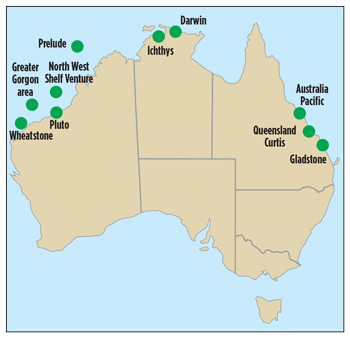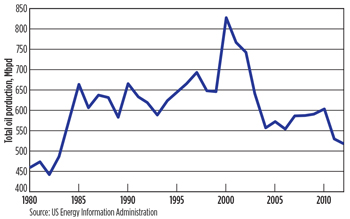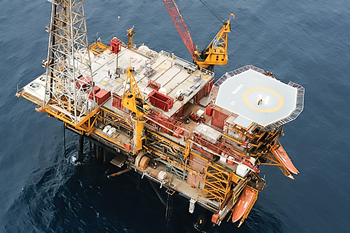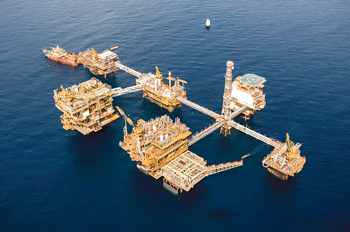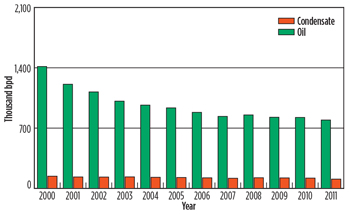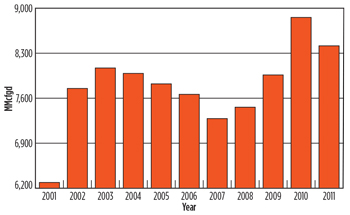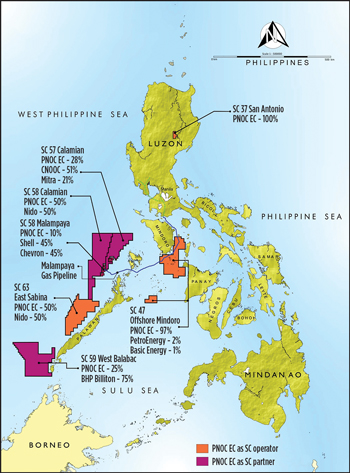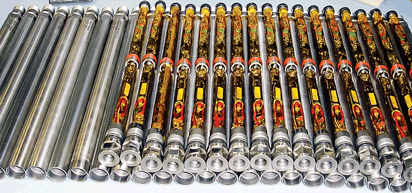Regional Report: Australia/Southeast Asia - Newcomers vie with region’s heavy hitters to meet soaring demand
Australian and Southeast Asian oil and gas producers are benefiting from soaring demand, both domestically, and through exports to thirsty Asian economies, such as China, India, Japan and South Korea. Australia’s gas and LNG sector is the biggest investment magnet, attracting hundreds of billions of dollars, but some of the region’s smaller producers are also on the rise. Countries, such as the Philippines and Vietnam, have raised hydrocarbon production from next-to-nothing to become respectable players over the last decade or so. Those with longer production histories have had mixed fortunes. While Indonesia has struggled to maintain oil output as its biggest fields mature, Malaysia has managed to stabilize production. AUSTRALIAAustralia is poised to become the world’s largest LNG exporter within five years. Construction of a slew of offshore gas and LNG projects is absorbing hundreds of billions of dollars, and creating labor and equipment shortages that push costs higher. These costs, together with uncertainties over long-term global gas demand and Australia’s own requirements, are causing companies to re-assess further LNG expansion. But in the short-term, the sector remains buoyant. Oil production is declining, as explorers struggle to find reserves to replace maturing older fields. Shale oil explorers in Australia’s interior hope to offset some of the decline. Efforts to boost offshore gas and oil supplies are taking explorers into deeper waters of the Timor Sea. Onshore, coalbed methane (CBM) is being exploited to feed Queensland’s LNG projects. Natural gas. Australia remains an LNG investment magnet. The three projects already operating produce around 24 MMtpa between them, while another six under construction, and Prelude, the world’s first large-scale floating LNG (FLNG) project, should boost total capacity to more than 80 MMtpa by 2017, according to the Australian government. That should make the country the world’s largest exporter. Two-thirds of recent LNG investment globally has gone to Australia, supported by a possible tripling of its annual gas production to around 5.4 Tcf by 2035 from 1.8 Tcf in 2011, according to an International Energy Agency (IEA) forecast. Spiraling costs, inflated by a tight labor market and a strong Australian dollar, are already cutting into margins and putting a lid on commitments to new Australian hydrocarbon projects. Meanwhile, the looming prospect of North American LNG exports heading into Asia is forcing buyers in the region to push for longer-term, lower-cost supply agreements. LNG projects. The three existing LNG facilities, all based on offshore reserves, include the North West Shelf Venture, the Darwin LNG project, and the Pluto plant, Fig. 1. Western Australia’s five-train, 16.3-MMtpa North West Shelf Venture (NWS) has been operated by Woodside Petroleum since 1989. Faced with dwindling supply from NWS’s existing reserves, Woodside, in October, completed a $5-billion redevelopment of North Rankin and Perseus fields to extract low-pressure gas. The development provides 5 Tcf of new supply to NWS.
The single-train, 3.5-MMtpa, Darwin LNG project in Northern Territory began production in 2006. The ConocoPhillips-operated project is based on Timor Sea reserves. Woodside’s single-train, 4.3-MMtpa, Pluto LNG plant near Karratha, Western Australia, shipped its first LNG cargo during April 2012, based on gas from an offshore project operated by the company. The $15-billion project experienced an unplanned shutdown earlier this year, due to technical issues. Among the six LNG projects under construction, (Fig. 1) three are tied to offshore gas reserves, and three are based on onshore CBM. Those based on offshore reserves include Gorgon, Wheatstone and Icthys. Chevron’s $15-billion-plus Gorgon project, on Barrow Island off Western Australia, should start up in 2015. It comprises a three-train, 15.6-MMtpa LNG plant and a domestic gas facility. Gas for this project comes from Gorgon and Jansz-lo offshore fields, estimated to hold around 40 Tcf of recoverable resources. Fast-rising costs have caused the project to exceed budget by around 20%. In Western Australia’s Pilbara region, Wheatstone is Chevron’s second major Australian investment. The $29-billion-plus project should go onstream in 2016, initially producing 8.9 MMtpa from two trains, with plans to add two trains later. Inpex’s $34-billion Ichthys project will start up during 2016, in Darwin. The two-train, 8.4-MMtpa plant will take gas from offshore fields through an 800-km pipeline, and also produce 100,000 bcpd and 1.6 MMtpa of LPG. The CBM projects under construction are on Curtis Island, near Gladstone on the Queensland coast. They include Queensland Curtis LNG (QCLNG), Australia Pacific LNG (APLNG) and Gladstone LNG (GLNG). The BG-operated QCLNG project is based on CBM reserves held by the company’s QGC unit. BG expects to have drilled some 2,000 wells in the basin by 2014, when the two-train, 8.5-MMtpa facility goes online. First gas was delivered to the plant in December 2013. Similar to other LNG projects, QCLNG has been hit by budget overruns and is now expected to cost more than $20 billion. In November, China’s CNOOC increased its stake in train 1 to 50% from 10%, for $1.93 million. CNOOC now has an option to take a stake of up to 25% in a further train, should it be built. Origin’s $24.7-billion, two-train APLNG project is based on gas piped 530 km from the Surat and Bowen basins. The first train should be operational in mid-2015, while the second is expected to be running by the end of that year, at which point the project will have an 8.4-MMtpa capacity. Sinopec and Japanese power company Kansai Electric have signed 20-year deals to take 7.6 MMtpa and 1 MMtpa, respectively. The Santos-operated, two-train, GLNG Project is due to start production in 2015. The $18.5-billion, 7.8-MMtpa venture is also based on gas from the Bowen and Surat basins, and will share some pipeline structure with APLNG. Another possible CBM-based LNG project on Curtis Island, Arrow LNG, received governmental approval in December 2013. However, the fate of the $10-billion-plus project remains in the balance, as Shell is striving to cut its global investment budget. Floating LNG. As the cost of land-based LNG spirals, floating LNG (FLNG) is coming into its own. The Shell-pioneered technology is set to make its debut at the company’s Prelude gas field off Western Australia, where the world’s largest floating structure is due to start producing LNG in 2017. While the Prelude vessel will produce only around 3.6 MMtpa, it also costs considerably less to build, and get running—around $13 billion or so. The benefits are such that Woodside seems poised to adopt Shell’s FLNG model for its Browse development off Western Australia. Oil production. Australian oil output has declined sharply since 2000. According to U.S. Energy Information Administration (EIA) data (Fig. 2), the country produced 406,000 bopd in 2012, compared with a peak of around 722,000 bopd in 2000, as yields from mature basins fall away, with few new discoveries to replace them. Hopes for reviving conventional oil production lie in efforts to boost condensate output; commercialization of smaller fields; and enhanced exploration in the deeper waters of the Timor Sea.
Australia’s proven oil reserves total more than 1.4 billion bbl. The Carnarvon basin off northwestern Australia provides almost 75% of national liquids production. Several companies are studying the viability of producing shale oil onshore. TIMOR-LESTE (EAST TIMOR)This impoverished country is fighting in international courts to protect its involvement in developing reserves that straddle its maritime border with Australia. The Timor Leste government wants gas from Greater Sunrise field to be sent via undersea pipeline to an LNG facility that would be built onshore Timor-Leste. Field operator Woodside prefers a plan to develop the field using FLNG, claiming that the pipeline option would be too expensive, and that Timor-Leste’s infrastructure is insufficient to handle the project. The dispute is tied to debate over the terms of international treaties governing Greater Sunrise and the maritime border, which determine how much oil belongs to each country. In 2013, Timor-Leste filed for arbitration, claiming that Australia carried out espionage during negotiations for one of the treaties, which came into force in 2007, insisting that this had made it invalid. In December 2013, proceedings began in the Permanent Court of Arbitration in The Hague, The Netherlands. Greater Sunrise comprises the Sunrise and Troubadour gas/condensate fields, 150 km southeast of Timor-Leste and 450 km northwest of Darwin, Australia. The fields hold gross contingent resources of 5.1 Tcf of gas and 225.9 MMbbl of condensate. NEW ZEALANDA fresh wave of exploration licensing reflects the New Zealand government’s desire to boost flagging oil and gas production. Oil production totaled 16.6 MMbbl in 2012, according to governmental data. Remaining reserves (on a P50 basis) are estimated at 149 MMbbl for producing fields, mainly Maari, Pohokura and Tui fields. New Zealand relies heavily on oil imports, but is self-sufficient in gas. The giant offshore Maui gas field (Fig. 3) was one of the world’s largest when discovered in 1969, but this is depleting. Most gas now comes from Pohokura field, which went online in 2006. New Zealand produced 163 Bcfg in 2012.
Taranaki basin covers some 100,000 km on the North Island’s west coast, most of it offshore. Yet, most producing fields are onshore, where it is cheaper to drill. In December 2013, 10 new exploration licenses, representing $62 million in committed expenditures, were issued. They include a permit for the deepwater Reinga-Northland area, off the North Island’s northern tip, plus three onshore and two offshore areas in the Taranaki basin, two onshore areas on the North Island’s east coast and two areas in the Great South-Canterbury basins off the South Island’s east coast. Meanwhile, asset management company Carlyle Group said it would invest $200 million over three years in Discover Petroleum’s New Zealand Taranaki/Canterbury basin program with operator Anadarko. PAPUA NEW GUINEAPapua New Guinea’s proven natural gas reserves total 5.58 Tcf, according to EIA. These form the basis for one LNG plant already under construction and possibly another one, still under review. The first gas from PNG LNG, which is being developed by Exxon Mobil, will ship during second-half 2014. The project’s two-train plant is 20 km northwest of Port Moresby and supplied by gas from the onshore Hides, Angore and Juha fields, as part of an integrated development linked by over 700 km of pipelines. As with similar projects in Australia, costs for the 6.9-MMtpa development have climbed, and are expected to reach $19 billion. The plant is forecast to produce more than 9 Tcf of gas over its lifetime. Exxon could make an investment decision on a third train in 2015. Another LNG plant may now be built, following December’s announcement by InterOil, that it had signed a $3.6-billion deal, under which Total would take a 61.3% stake in Elk and Antelope fields, which may hold up to 5 Tcf of gas. Total says it could then farm out up to 19.3% to another firm. A final investment decision on the project is not expected until 2016. The move provides InterOil with a strategic partner to develop a proposed one-train, 3.8-MMtpa facility, Gulf LNG. Oil Search also said in December that it has been in talks over the possible acquisition of a stake in Elk and Antelope. MALAYSIAIn contrast to Indonesia, Malaysia is reversing oil production declines, while continuing to boost gas output. A $30-billion investment program during 2008-2011, which implemented EOR in mature fields, and developed deepwater and marginal fields, is paying dividends. Total oil production rose to 643,000 bpd in 2012 from 626,000 bpd in 2011, after several years of decline, according to EIA. Proved oil reserves are estimated at 4 billion bbl. While production is unlikely to rise to the peak, 800,000-bopd level of a decade ago, state firm Petronas says it could reach 700,000 bopd for a time, as new fields go onstream over the next five years. Much of the new production will come from Shell-operated fields offshore Sabah, Fig. 4. Gumusut-Kakap field could add some 120,000 bopd, when a new terminal is completed in 2014.
Gas production has climbed steadily for 30 years, now reaching 6 Bcfgd, supplying the world’s second largest LNG export industry. A string of recent discoveries could push output to around 7 Bcfgd by 2018, according to consultancy Wood Mackenzie. Malaysia’s proved gas reserves total around 83 Tcf. Malaysia exports around 24 MMtpa of LNG from its plant at Bintulu in Sarawak. The plant is being expanded, with a further 6.3 MMtpa of capacity due to become operational by 2016. Petronas is also building a 1.2-MMtpa FLNG vessel, for Kanowit field, 180 km off Sarawak, set for commissioning in 2015. Petronas awarded a record 13 PSCs in 2012, spurred by fiscal incentives for E&P that have encouraged several firms to take acreage. On the other side of the equation, U.S. firm Newfield Exploration said in October that it was selling its Malaysian interests for $898 million to local firm SapuraKencana Petroleum. Recent E&P developments. Petronas and Hess started gas production from the North Malay basin project offshore peninsular Malaysia. The start-up was confirmed in December by EOC Ltd., the Norwegian firm that supplied the project’s FPSO. The partners are exploiting nine stranded gas fields off Terengganu. They have 50% stakes, each, in Blocks PM302, PM325 and PM326b, and plan to invest more than $5 billion in the project over the next five years. Reserves are estimated at 1.7 Tcf of gas. Production should reach 100 MMcfgd in the first development phase, and 300 MMcfgd in the second phase after 2017. Offshore Block 320, 240 km northwest of Bintulu in Sarawak, has now yielded three discoveries for operator Mubadala Petroleum. In October, Petronas said the Pegaga-1 well, in 108 m of water, was drilled to a 2,029-m TD and encountered a 247-m gas column. In December, Petronas said that the Sintok-1 well had been drilled to a depth of 2,775 m and found a 292-m gas column. Drillers found gas in another well on the block during 2012. In January, Malaysia’s first onshore discovery since 1989 was unveiled. Operator JX Nippon Oil & Gas Exploration found oil and gas in the Adong Kecil West-1 well. Some 349 m of net hydrocarbons were encountered in the well, drilled to 3,170 m. INDONESIAIndonesia seeks to boost production from declining, mature oil and gas fields, and explore for fresh reserves. The serious declines have transformed the country from Southeast Asia’s largest oil exporter to a net importer. Indonesia has proved oil reserves of 4.04 billion bbl, according to upstream regulator SKK Migas. A similar transformation is happening in the gas sector. The country remains the world’s third largest LNG exporter, sending some 18 MMt abroad in 2012. Early in 2013, BP said that its plans to add a third train to its Tangguh LNG project by 2019 were still on track. But Indonesia’s largest gas fields are depleting, forcing it to turn to LNG imports to balance exports committed under long-term contracts. Indonesia has proven gas reserves of around 104.7 Tcf. Much foreign E&P involvement is done under PSCs granted by SKK Migas. The agency was established by the energy ministry to carry out regulation temporarily, after its predecessor, BP Migas, was declared to be unconstitutional in November 2012. An unsettled investment climate has led to poor responses in recent licensing rounds. Oil E&P. Indonesia’s crude production has slid from around 1.6 MMbpd in 1991 to less than 857,000 bpd in 2012, Fig. 5. EOR techniques and new finds have failed to offset dwindling supplies from mature fields. SKK Migas estimates that Indonesia’s oil reserves will only be enough for 10-11 years of production.
The government hopes to reverse this trend by developing the Cepu Block in eastern and central Java, where oil was struck in 2001. Operated by Exxon Mobil, the block contains several sizeable fields, including Banyu Urip, Jambaran and Cendana, whose combined output could peak at 165,000 bopd, compared to around 24,000 bopd in early 2013. However, the project has been hit by delays. The regulator expects full production from a 25-well expansion to be achieved by the end of 2014. The country’s largest producing fields, which are also the oldest, are Duri and Minas, on the east Sumatran coast. Duri produces some 185,000 bopd, while Minas produces about 70,000 bopd. Chevron, the license-holder for both, has employed steamfloods across Duri since the 1970s, and they now are used on about 80% of the field. In October 2012, Chevron embarked on the $500-million North Duri Development (NDD) Area 13 project, which could add 17,000 bopd to Duri’s production, when completed. The project includes 358 producing wells, 145 steam injectors and 36 temperature observation wells. Plans are also in process to boost oil production at Minas field through EOR. SKK Migas has suggested that the field’s output could be raised to 180,000 bopd by 2021, according to media reports. Another main oil producing area is the East Java basin, where Pertamina and PetroChina have a joint operating agreement. The area produces around 43,000 bopd, with plans to raise production by up to 10,000 bopd in coming years. Gas E&P. Traditionally, Indonesia has been a major gas exporter, but surging demand at home, coupled with production setbacks, has forced the country to turn to LNG imports on the spot market to compensate in recent years. Indonesia produced around 2.7 Tcf of gas in 2011, over 40% more than a decade earlier, Fig. 6. During the same period, domestic gas consumption rose more than 80% to 1.33 Tcf, and local demand is growing around 10% annually. Accordingly, Pertamina signed its first, long-term, LNG import contract to take supply from Cheniere Energy’s new project in Texas. Pertamina will buy 800,000 tpa of gas, beginning in 2018, under a 20-year deal.
Indonesia needs new reserves urgently, as some of its biggest gas fields are depleting. In December, Total said production from the 46-year-old Mahakam Block in East Kalimantan, which produces almost a third of total Indonesian gas output, would fall by around a third by 2017. The block is expected to produce 1.66 Bcfgd in 2014, compared with 1.76 Bcfgd in 2013. Exploration offshore, where over 60% of conventional gas reserves may be located, will become increasingly important to offset declines. The Arafura Sea in eastern Indonesia holds the Inpex-operated Abadi gas field, holding up to 14 Tcf of reserves, which could be exploited with FLNG technology. In October, Abu Dhabi’s Mubadala Petroleum said that it had started production from Ruby gas field offshore East Kalimantan. Ruby’s flow may peak at 100 MMcfgd for four years, and it should produce 214 Bcf over 10 years. VIETNAMVietnam has developed into one of Southeast Asia’s leading hydrocarbon producers and is a net exporter, having attracted foreign explorers to the country by loosening investment restrictions and reforming markets. Following a string of discoveries, proved oil reserves have shot up to 4.4 Bbbl in 2013, compared to 600 MMbbl in 2011. There is potential for more to come. State oil firm Vietnam Oil & Gas Group (PetroVietnam) says the country will maintain current oil production levels of around 340,000 bpd for “the next few years.” Crude production was 347,000 bpd in 2012, while total oil production averaged 363,000 bpd, down from a peak of around 400,000 bpd in 2004, but up 12% from 2011’s figure. Vietnam produced 272 Bcf of gas in 2011, and has 24.7 Tcf of proven gas reserves. As the industry regulator, PetroVietnam participates in all E&P projects, and IOCs must negotiate licenses with the company. Vietnam’s production comes from fields off the southern coast, mainly in the Cuu Long basin. However, recent finds have been made in increasingly remote locations. In October, a well at Te Giac Trang field on the H5 Block of Cuu Long basin tested at more than 27,600 boed. Operator Soco International said the test had increased the resource estimate to 150 million-200 million bbl, from a prior estimate of 50 million-100 million bbl. Te Giac Trang production averaged 45,132 bopd during Jan.-Oct. 2013. PHILIPPINESRising oil and gas production, while still modest, reflects a major push to develop the country’s resources since the turn of the millennium. Despite the gains, the Philippines will remain a net oil importer for the foreseeable future, while all gas is used domestically. Oil production averaged around 25,240 bpd from proved reserves of around 14 million bbl in 2012. Gas production stood at 102.41 Bcf in 2011, with proved reserves estimated at 3.48 Tcf, according to EIA. Most oil comes from the southeastern edge of the South China Sea. There, Galoc field, 60 km northwest of Palawan Island, is the main source of new output. In December, operator Otto Energy said that Phase II of the development had boosted production to more than 4,000 bopd, and that field life had been extended to around 2020. Shell operates the country’s biggest gas field, Malampaya, near Galoc. The project’s Phase 3 aims to maintain supply of natural gas to Luzon’s electricity grid by adding a new platform by 2015. Malampaya has estimated reserves of around 2.7 Tcf. A number of promising exploratory tracts lie south and east of Malampaya Field (SC 38), Fig. 7.
The Department of Energy failed to attract bids from IOCs for new blocks in parts of the South China Sea, where the Philippines is disputing maritime ownership with China. Bidding round results, announced in mid-2013, showed interest mainly from local firms. A Philippines energy ministry official, quoted by international media in October, said Forum Energy, a subsidiary of Philex, was trying to work around the problem by holding talks with China’s CNOOC on a possible joint exploration venture in Sampaguita field, estimated to hold 20 Tcf of gas in the disputed Reed Bank area. THAILANDDespite rising oil and gas production, a heavy reliance on imports has prompted state energy firm PTT to embark on an international expansion strategy. The company is spending $12 billion on capital investments during 2012-2016, of which 50% goes to overseas projects. Of that latter amount, $3 billion is earmarked for oil and gas projects in Myanmar. PTT’s upstream arm, PTT Exploration and Production (PTTEP), is an increasingly prominent player across Southeast Asia and further afield. Thailand produced 433,000 bopd in 2012, with proved reserves of 450 MMbbl. Gas production amounted to 1.3 Tcf in 2011, while proved reserves are around 10 Tcf, according to EIA data. Thailand’s largest oil fields lie in the Pattani Trough of the Gulf of Thailand. Chevron has boosted its E&P effort there, as supply from existing fields declines. In 2012, the company installed 12 wellhead platforms and drilled 325 development wells, along with six exploration wells. Most of the country’s gas also comes from the Pattani Trough. The largest field, Bongkot, went onstream in 1993. The Greater Bongkot South (GBS) gas/condensate field, which started production on April 2012, can process 350 MMcfg and 15,000 bcpd. GBS is operated by PTTEP, with partners Total and BG Group. Chevron’s Platong II project came online in late 2011 and should ramp up to 330 MMcfgd. Meanwhile, the Chevron-operated Ubon gas/condensate project is also progressing, with a decision on contracts for a central processing platform due shortly. Ubon could start producing in 2016, at 130 MMcfgd. Thailand also receives gas from the Malaysia-Thailand Joint Development Area (JDA). MYANMARThe Ministry of Energy said at the end of November that 30 companies had bid in the final phase of Myanmar’s debut offshore licensing round, about half the number that were qualified to bid. Previously, blocks had been allocated through direct talks with companies. Among bidders were groups led by Exxon Mobil, BG, Daewoo, Total, PTTEP, Eni, Shell, ConocoPhillips, Woodside, Petronas, Statoil and Repsol. Details of which firms bid for which blocks were not revealed, although some firms bid for more than one block. On offer were 19 deepwater tracts and 11 shallow water blocks, in the Rakhine, Moattama and Tanintharyi offshore areas of the Andaman Sea and Bay of Bengal. Myanmar already produces gas, totaling 420 Bcf in 2011. Proved reserves are about 10 Tcf. Roughly three-quarters of gas output is exported to Thailand via pipeline. These exports will grow with the development of PTTEP-operated Sawtika field in the Gulf of Martaban. First gas is expected soon, with a peak rate of 345 MMcfd targeted. A pipeline carrying gas from Shwe field (operated by Daewoo) to China was reported by Chinese media in October to have become fully operational. The pipeline can carry up to 500 MMcfd, when Shwe’s peak production is achieved. A crude pipeline along the same route has also been built. CAMBODIACambodia has yet to agree with Chevron over development of its first hydrocarbon field project, in Block A offshore. Chevron applied for a production permit in 2010, having declared the block commercial in the Khmer Trough of the Gulf of Thailand, following successful exploration. Cambodian National Petroleum Authority is reportedly still in talks with Chevron and says it expects to issue a production permit shortly. The country has designated six offshore blocks (A to F) and 19 onshore blocks (I to XIX), plus further acreage in an area disputed with Thailand.
|
- Applying ultra-deep LWD resistivity technology successfully in a SAGD operation (May 2019)
- Adoption of wireless intelligent completions advances (May 2019)
- Majors double down as takeaway crunch eases (April 2019)
- What’s new in well logging and formation evaluation (April 2019)
- Qualification of a 20,000-psi subsea BOP: A collaborative approach (February 2019)
- ConocoPhillips’ Greg Leveille sees rapid trajectory of technical advancement continuing (February 2019)


